What do we talk about when we talk about portable electric car chargers?
- The #1 most common version is a battery charger that typically plugs into a regular NEMA 5-15 outlet or other types of outlets in the home. Its compact size and lightweight design allow it to be carried in your trunk, hence its name: portable charger. Click here for a model overview.
- The #2 most common is a mobile charger based with gasoline generator. The cost of the equipment is much higher. We’ve written more about this here.
- The #3 most common is the Portable Power Station, which uses a rechargeable battery. Read more here.
Portable electric car chargers that plug into an outlet
General Characteristics:
- Charge your EV by plugging it into the wall
Variations:
- Differing voltages and levels
- Socket type
- Charging rate
- EV plug-in: J1772 or Tesla
- Ability to be mounted
Best Level-1 portable devices (120 volts)
- $15999Prime
eligibleDec 13, 2025 6:15 PM - Get a great dealDec 13, 2025 6:15 PM
- OEM 12-16 amp, supplied with the electric car
- Lectron1 120v, 16amp, 21 ft.
- Megear 120v, 16amp, 25 ft.
Best portable Level-2 EV chargers (240 volts)
- OEM 16-32 amps that come with the electric car
- Mustard2 240V, 40 Amp, NEMA 14-50 Plug, 25 ft
- Lectron 240V, 40 Amp, NEMA 14-50 Plug, 18
The best universal Level-1/Level-2 portable chargers
- OEM 16-48 amps, which come with the electric car, such as the Nissan Leaf3 Plus (14-50/5-15) or Tesla (Universal Mobile Connector4)
- MEGEAR 120v-240v, 12 Amp / 20 Amp, NEMA 5-15 (1.4 kW) / NEMA 6-20 Plug (3.8kW)
- MUSTART TRAVELMASTER 120v-240v, 12 Amp / Amp40 , NEMA 5-15 (1.4 kW) / NEMA 155-0 Plug (9. 6 kW)
- BougeRV 120v-240v, 12 Amp / 20 Amp, NEMA 5-15 (1.4 kW) / NEMA 6-20 Plug (3.8kW)
- And others like ZENCAR, Book Engine.
Most electric cars come with portable chargers
When you buy a new electric car, in most cases you will find in the package a portable device (120-volt) for connecting to your home power grid. Some electric cars come with more powerful devices capable of 120 and 240 volts (such as the Turbocord from BMW5 or the more successful OEM for the Audi e-tron).
The devices adapted to the different current (120/240) independently determine the lower or higher incoming voltage, synchronize with the power supply limits of the electric car, and then deliver different power current depending on the situation.

The difference in portable chargers by voltage
- 120 volts, this is Level 1. These are sockets 5-15 (1,440 watts) or 5-20 (1,920 watts)
- 240 volts, this is Level 2. Example sockets, 6-20 (3,840 watts) or 14-50 (9,600 watts)
Depending on the electric car, at Level 1 the charging speed will be 3–5 mph, and when you connect a Level-2 device the speed will increase to 20–40 mph. Since we are talking about portable devices here, we do not take into account other hardwired chargers up to 80 amps.
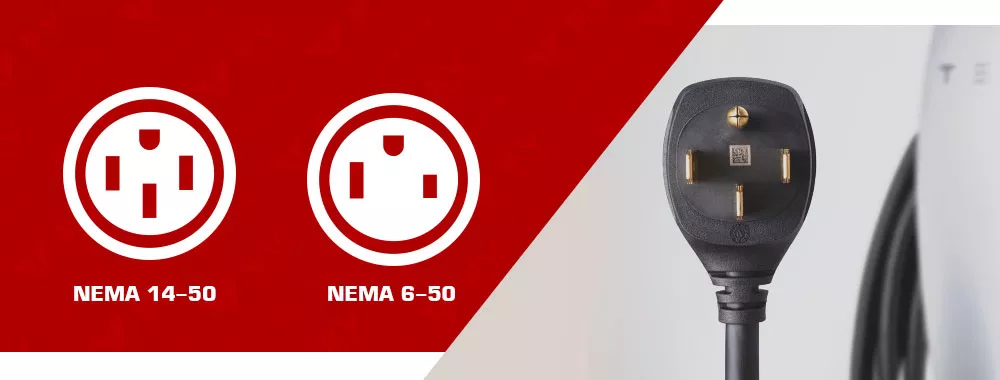
Where do I get 240 volts for the charger?
240 volts can charge your electric car six times faster than a regular 120-volt outlet. A simple but temporary way to connect to 240 volts can be an outlet from your air conditioner or clothes dryer. If you decide to use the charger permanently, it’s more practical and safe to contact an electrician and arrange for a separate outlet, NEMA 6-20 or NEMA 14-50, near the unit’s planned connection.

Does it live up to what it claims?
If you have a 50-amp breaker, the standard is that the device can only get four-fifths of the rated power. Therefore, if you connect a portable battery charger to a NEMA 14-50, it will only get 40 amps. So do the math: 40 amps times 240 volts equals 9,600 watts.

Portable electric car chargers from a gasoline generator
The Blink portable EV charger6 is a specially designed device that runs on gasoline. Its price is 4–5 times higher than the average power generator, when chosen with the right parameters, can be used to recharge electric cars.
Some models of portable generators are quite compact and can help on the road, but the charging speed is not high. The more powerful 12kW models are less often purchased by enthusiasts. It is important to note that not all models are suitable for chargers. We wrote about the requirements for such gasoline generators in this review.
Portable battery-powered electric car chargers
Electric car owners use both specialized devices (ZipCharge or Roadie) and non-electric car charging stations for portable charging from a spare battery.
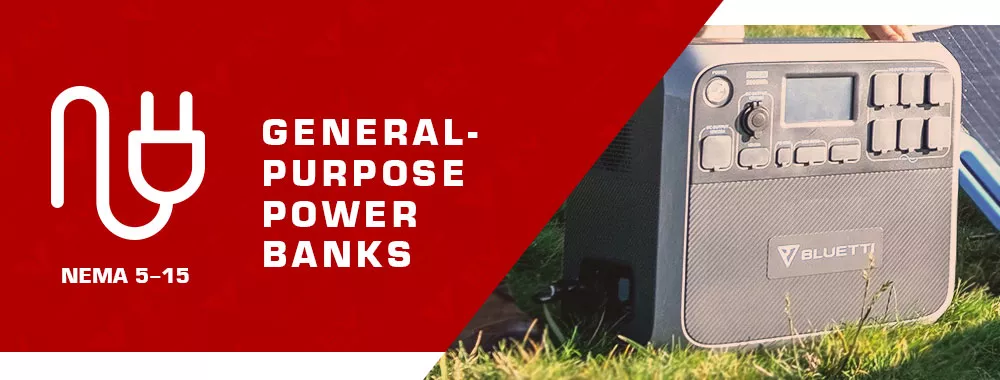
Power bank models for a NEMA 5-15 socket (AC)
You can find general purpose power banks or a hybrid battery and J1772 charging cable on sale, though these models may contain a drawback:
- Many models use alternating current at the output, which is then converted back to direct current by the electric car’s power unit. This inefficient approach provides a low charging rate of 1 mile per hour of charging.
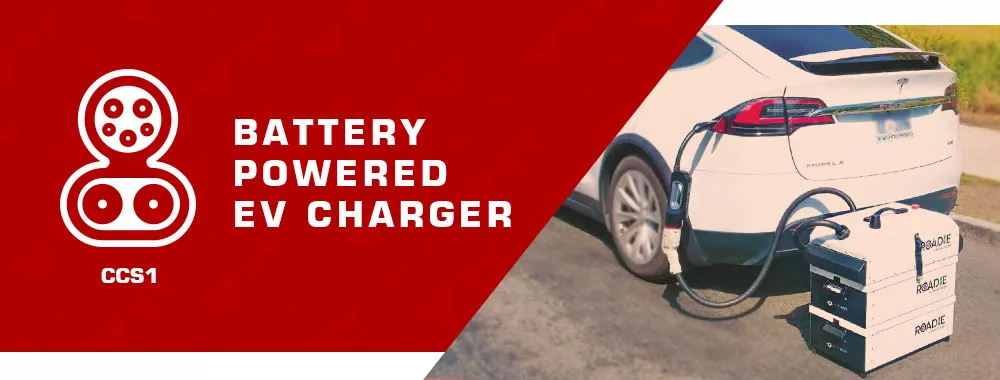
Roadie by Spark charger – portable emergency battery for electric cars
This is a DC charger (this current does not come from an outlet) designed primarily for roadside assistance. Its modular construction contains several units, each about 3.7kWh.
Depending on the number of units, the electric car’s possible mileage from the resulting charge is determined. Roadie7 predicts 17.5 kWh, which, depending on the electric car model, will provide 65–75 miles after charging. This is based on an average speed claimed at around 60 mph, which means you can get enough charge for 15 miles in 15 minutes.
CCS1 is the plug used, which makes it clear that charging will be done with a constant current and at a good rate. The CCS connector is not a problem for the Tesla because there is an adapter.
In addition to roadside assistance, this kind of handheld device is offered in some states to regularly charge electric cars on a subscription basis. For $25 a month, the service will charge an electric car if it is in the service area. Convenient for apartment dwellers.
Popular portable charging stations: how long do electric vehicles charge
| Porsche Taycan | Ford Mustang Mach-E | Hyundai Kona | |
|---|---|---|---|
| EV portable charger • Level 1 • NEMA 5-15 • 1.4 kW | 35 h 43 min | 34 h 8 min | 16 h 47 min |
| EV portable charger • Level 2 • NEMA 6-20 • 3.8 kW | 13 h 9 min | 12 h 35 min | 6 h 11 min |
| EV portable charger • Level 2 • NEMA 14-50 • 9.6 kW | 5 h 13 min | 4 h 59 min | 3 h 16 min |
FAQ
Are there electric car chargers for plugging into a 5-20 outlet?
Yes, OEM chargers like these are offered by Tesla. Based on the maximum home outlet power (120 volts) of 20 amps, the charger can only consume 80%, i.e. the electric car will get 16 amps. To charge a non-Tesla electric car with the J1772 plug-in, using this kind of device is no problem along with the adapter.
What makes universal chargers charge 3 times faster if they are 16 amps?
If you consider models like the MEGEAR 120v–240v and others presented here with 6-20 plug-ins, you get 240 volts more power than 120 volts. You get double the voltage at 240 volts, compared with 120 volts, but you get 3.8 kilowatts instead of 1.4 kilowatts, more than double the kilowatts.
What is the most powerful and fastest portable charger for an electric car?
The most powerful portable charger is a device with a NEMA 14-50 socket connection. These devices are offered here and, they provide 9,600W (outgoing 40 amps) to the electric car.
What is a portable EV charging station?
Usually, when people mention a charging station, they mean a stationary device. So here you will find portable devices that are plugged into power outlets.
Which cars need Level-1 chargers?
Whether you have a Rivian or a Tesla, sometimes you may need to charge from a regular outlet (120 volts), and that’s what the Level 2 charger is for.
Is there a power bank for Tesla?
Yes, you can use DC models of the power bank for Tesla with the CCS to Tesla adapter. You’ll find the product list in our article here. Other low-performance portable solutions use the J1772 (AC) or Nema 5-15 to connect the Tesla Mobile Connector.
Can I charge an electric car with a portable battery?
Yes, you can charge from the special batteries discussed here without DC conversion. It is also technically possible from the large power banks published in our article, but you will get a slow charge rate.
Comparison table for level-1 portable devices (120 volts)
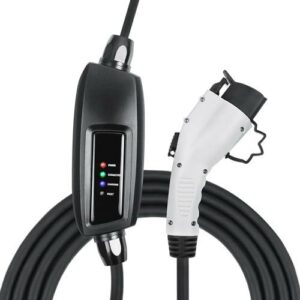 | 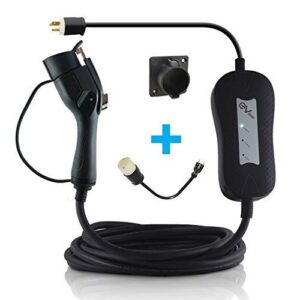 | 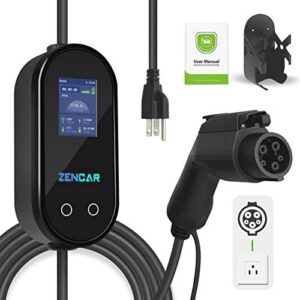 | |
| Lectron Level 1 Portable EV Charger NEMA 5-15 Plug, 16 Amp,... | EV Gear Level 1 Portable EV Charger 3.8 kW (120/240Volt, 30... | EVCARS ZENCAR Level 1 Portable EV Charger 1.92 kW (120Volt,... | |
| Overview | NEMA 5-15 Compatible with the supplied adapter. | ||
| Brand | Lectron | EV Gear | EVCARS |
| Amperage | 16 | 16 | 12 |
| Cable length, ft | 21 | 30 | 20 |
| Enclosure Material | n/a | n/a | n/a |
| Waterproof | No | IP55 | IP54 |
| Weight | 6.65 | 6.9 | 9.04 |
| Working temperature | -22°F to 122°F | n/a | n/a |
| Warranty | 1 year | 3 years | 1 year |
| Certificate | cULus lited, FCC Part 15 Class B | n/a | n/a |
Comparison table for level-2 portable devices (240 volts)
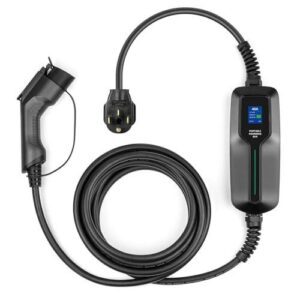 | 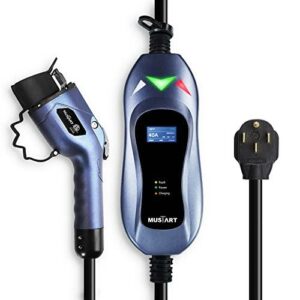 | 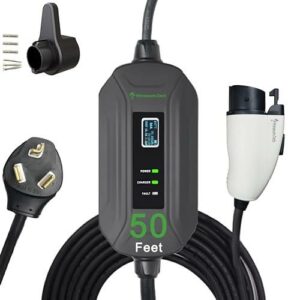 | |
| LEFANEV Level 2 Portable EV Charger NEMA 14-50 Plug, 9.6KW,... | MUSTART Level 2 Portable Electric Vehicle (EV) Charger (240... | PRIMECOM Level 2 Portable EV Charger NEMA 10-30P Plug, Long... | |
| Overview | Convenient cable length. LED display. | ||
| Brand | LEFANEV | MUSTART | PRIMECOM |
| Amperage | 40 | 40 | 16 |
| Cable length, ft | 25 | 25 | 50 |
| Socket | NEMA 14-50 | NEMA 14-50 | NEMA 10-30 |
| Waterproof | Yes | Yes | Yes |
| Weight | 10.53 | 14.01 | 11.82 |
| Working temperature | -40°F to 158°F | n/a | n/a |
| Warranty | n/a | 2 years | 1 year |
| Certificate | n/a | n/a | TV German Equipment and Product Safety Certification, CEcertifications, UL Listed Cable Certifications |
Comparison table for universal Level-1/Level-2 portable chargers
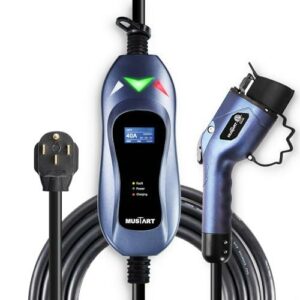 | 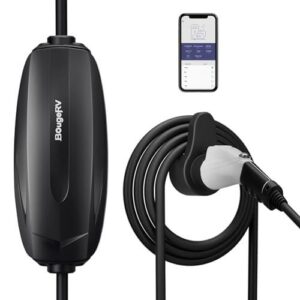 | 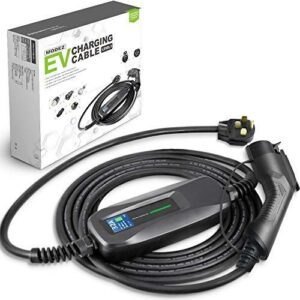 | |
| MUSTART TRAVELMASTER Level 1 and 2 Portable EV Charger (240... | BougeRV Level 1-2 Portable EV Charger (120/240 Volt, 25ft C... | Morec Level 2 and Level 1 Portable EV Charger (240 Volt, 26... | |
| Overview | It can be used on different voltages with little effort. It comes with adaptors for connecting to various outlets. When traveling, it works as a Level 2 and Level 1 device. | ||
| Brand | MUSTART | BougeRV | Morec |
| Amperage | 16, 24, 32 | 16 | 32 |
| Cable length, ft | 25 | 25 | 26 |
| Enclosure Material | n/a | ||
| Socket | NEMA 14-50, NEMA 5-15, NEMA 5-20 | NEMA 5-15, NEMA 6-20 | NEMA 14-50 |
| Waterproof | EV connector - Yes, Control Box - No | No | Yes |
| Weight | 11.88 | 8.18 | 8.8 |
| Working temperature | n/a | -22°F to 122°F | -22°F ~ + 122°F |
| Warranty | 2 years | 1 year | n/a |
| Certificate | n/a | n/a | CE & FCC & TUV |
Contents
- 1 Portable electric car chargers that plug into an outlet
- 1.1 Best Level-1 portable devices (120 volts)
- 1.2 Best portable Level-2 EV chargers (240 volts)
- 1.3 The best universal Level-1/Level-2 portable chargers
- 1.4 Most electric cars come with portable chargers
- 1.5 The difference in portable chargers by voltage
- 1.6 Where do I get 240 volts for the charger?
- 1.7 Does it live up to what it claims?
- 2 Portable electric car chargers from a gasoline generator
- 3 Portable battery-powered electric car chargers
- 4 Popular portable charging stations: how long do electric vehicles charge
- 5 FAQ
- 5.1 Are there electric car chargers for plugging into a 5-20 outlet?
- 5.2 What makes universal chargers charge 3 times faster if they are 16 amps?
- 5.3 What is the most powerful and fastest portable charger for an electric car?
- 5.4 What is a portable EV charging station?
- 5.5 Which cars need Level-1 chargers?
- 5.6 Is there a power bank for Tesla?
- 5.7 Can I charge an electric car with a portable battery?
- 6 Comparison table for level-1 portable devices (120 volts)
- 7 Comparison table for level-2 portable devices (240 volts)
- 8 Comparison table for universal Level-1/Level-2 portable chargers
Reference
- https://ev-lectron.com/products/lectron-portable-electric-car-charger-16a
- https://www.mustartpower.com/products/mustart-level-2-portable-ev-charger-240-volt-25ft-cable-40-amp-electric-vehicle-charger-plug-in-ev-charging-station-with-nema-14-50p-update-version
- https://parts.nissanusa.com/p/Nissan__/Case-Carry–EVSE/89591365/296M2-3NF0A.html
- https://shop.tesla.com/product/mobile-connector
- https://www.shopbmwusa.com/PRODUCT/5755/BMW-TURBOCORD-CHARGER
- https://blinkcharging.com/products/mobile-charger/?locale=en
- https://www.sparkcharge.io/

The ability to adjust the charging speed directly from the app is something I love. This charger will charge my new Volkswagen ID4 but it can also run up to 48 amps. It integrates well with my Emporia monitoring system to protect my home chains.
I’ve been using the MUSTART Level 2 for about 6 months now. The charging speed is impressive, and the digital display is super handy. Once during a rainstorm, I was worried about water damage, but the IP67 waterproofing held up. The only downside? The cable could be a tad longer for my garage setup. Thoughts?
I’ve had the PRIMECOM for a year now. While it’s a bit pricier, the build quality is top-notch. I agree with you on the cable length; seems to be a common issue with most chargers. Ever thought about getting an extension?
Has anyone tried the Splitvolt Level 2? I’m on a budget and wondering if it’s a reliable choice.
I’ve been using the Splitvolt for 3 months. For its price, it’s a steal. Charges my EV without any hitches. The 25-foot cable is a bonus. Go for it!
For newbies, here’s how to use the Lectron NEMA 14-50: 1. Ensure your EV’s software is updated. 2. Plug the charger into a NEMA 14-50 outlet. 3. Connect the charger to your EV. 4. Monitor the first few minutes to ensure a stable connection. Safety first, folks!
I drive a Nissan Leaf and am torn between the Nissan Carry Case EVSE and the Morec 40 Amp Level 2. Which one’s more durable in the long run?
I’d recommend the Morec 40 Amp. Been using it for my Leaf for over a year, and it’s still going strong. The Nissan Carry Case is decent, but I’ve heard it wears out faster.
I recently got the Mophie EV JuiceBox, and sometimes it doesn’t connect properly. I have to unplug and replug a couple of times. Anyone else facing this issue?
I’m comparing the Webasto Turbocord and the Lectron Portable for my Tesla. Both seem to have similar specs. Can anyone vouch for their performance and durability?
If you’re using the Besenergy Level 2, make sure to regularly check the plug for any wear and tear. A friend of mine didn’t, and it led to some charging inefficiencies. Regular maintenance goes a long way!
Just a heads up, there’s a sale on the Blink Mobile Charger on their official website. If you’ve been considering it, now’s a good time.
Anyone in the Seattle area interested in a group buy for the SparkCharge? I’ve contacted a local distributor who’s offering a discount for bulk orders.
Be cautious when using third-party chargers. Always ensure they’re compatible with your EV model. I’ve heard of a few cases where incompatible chargers led to overheating. Safety first!